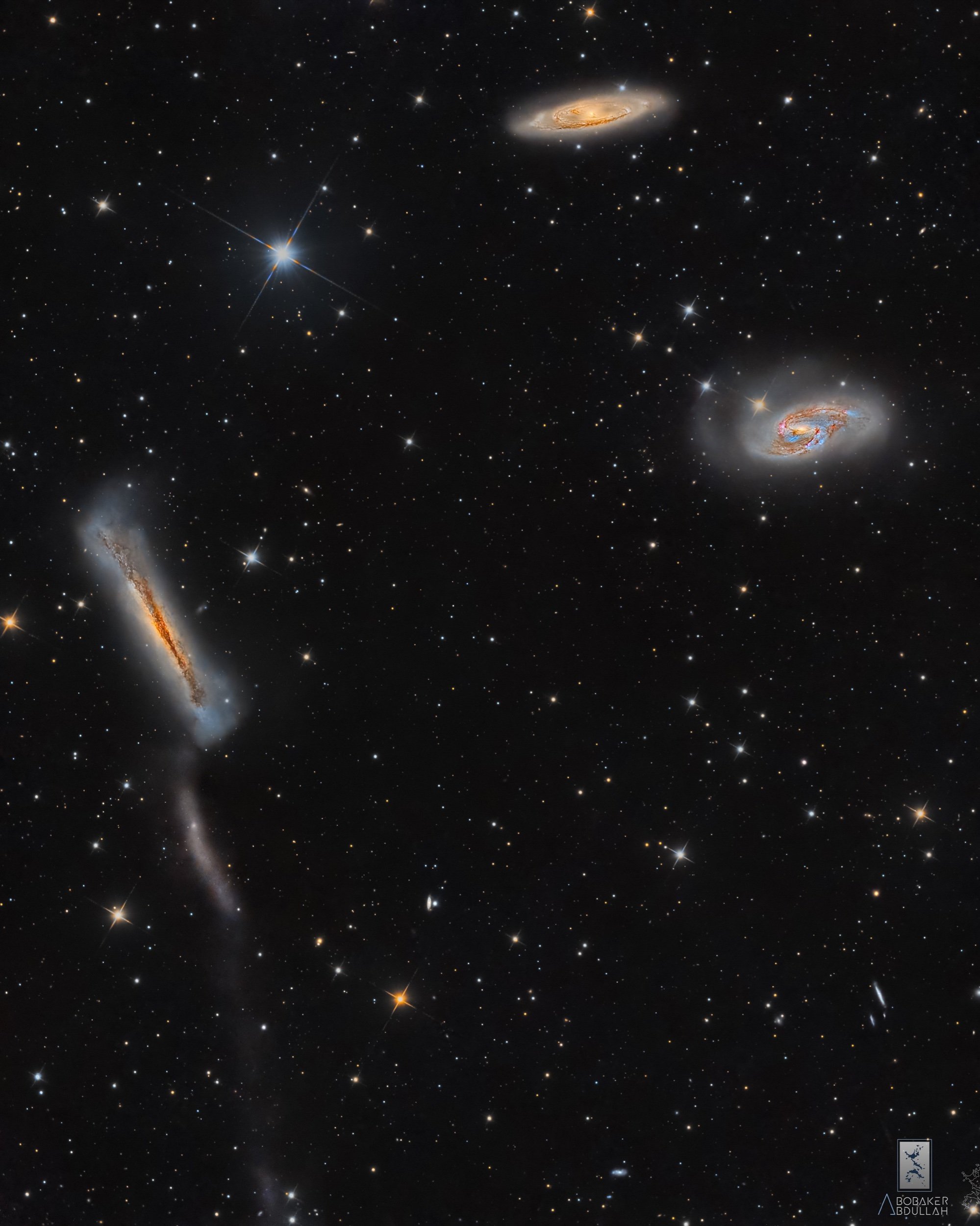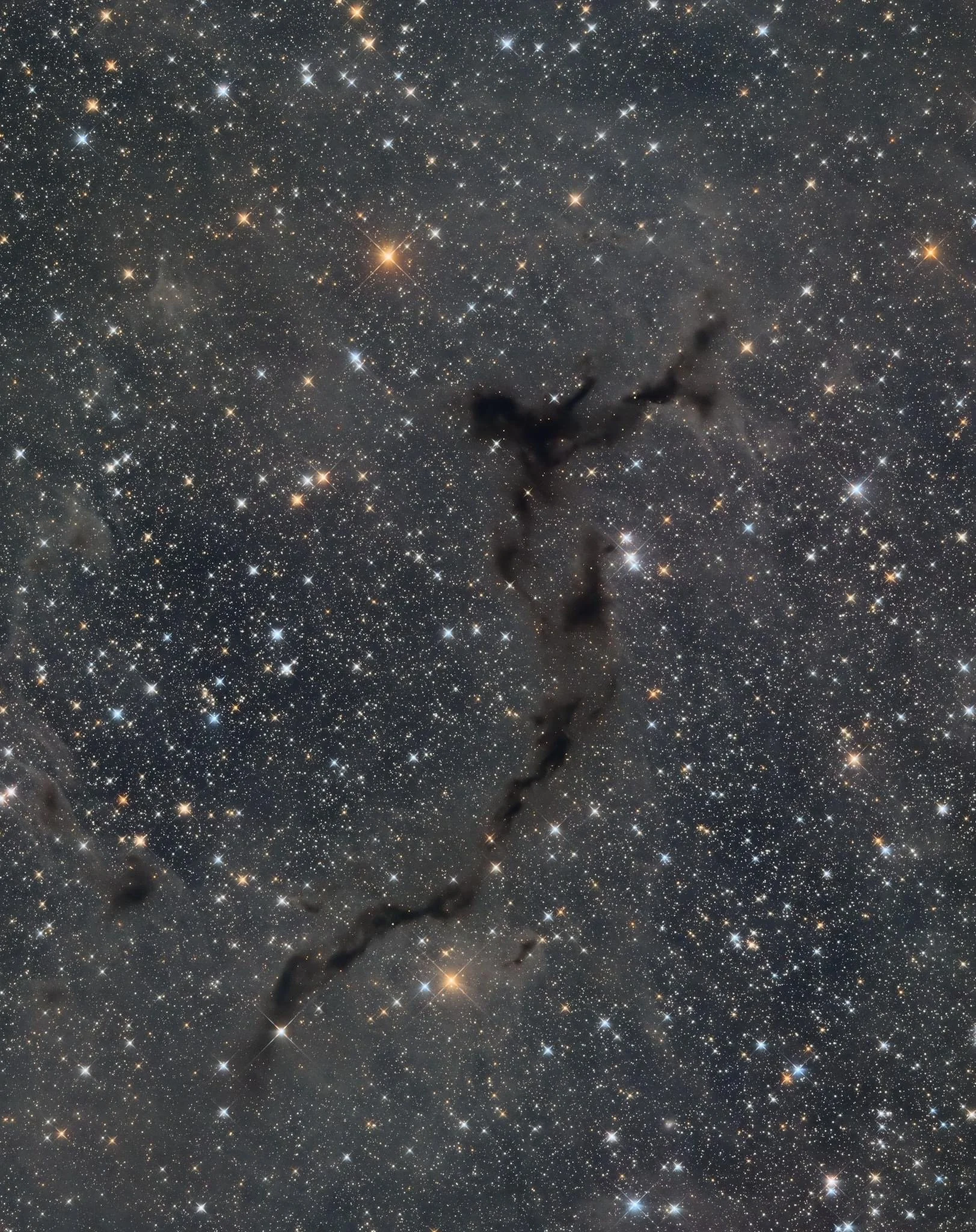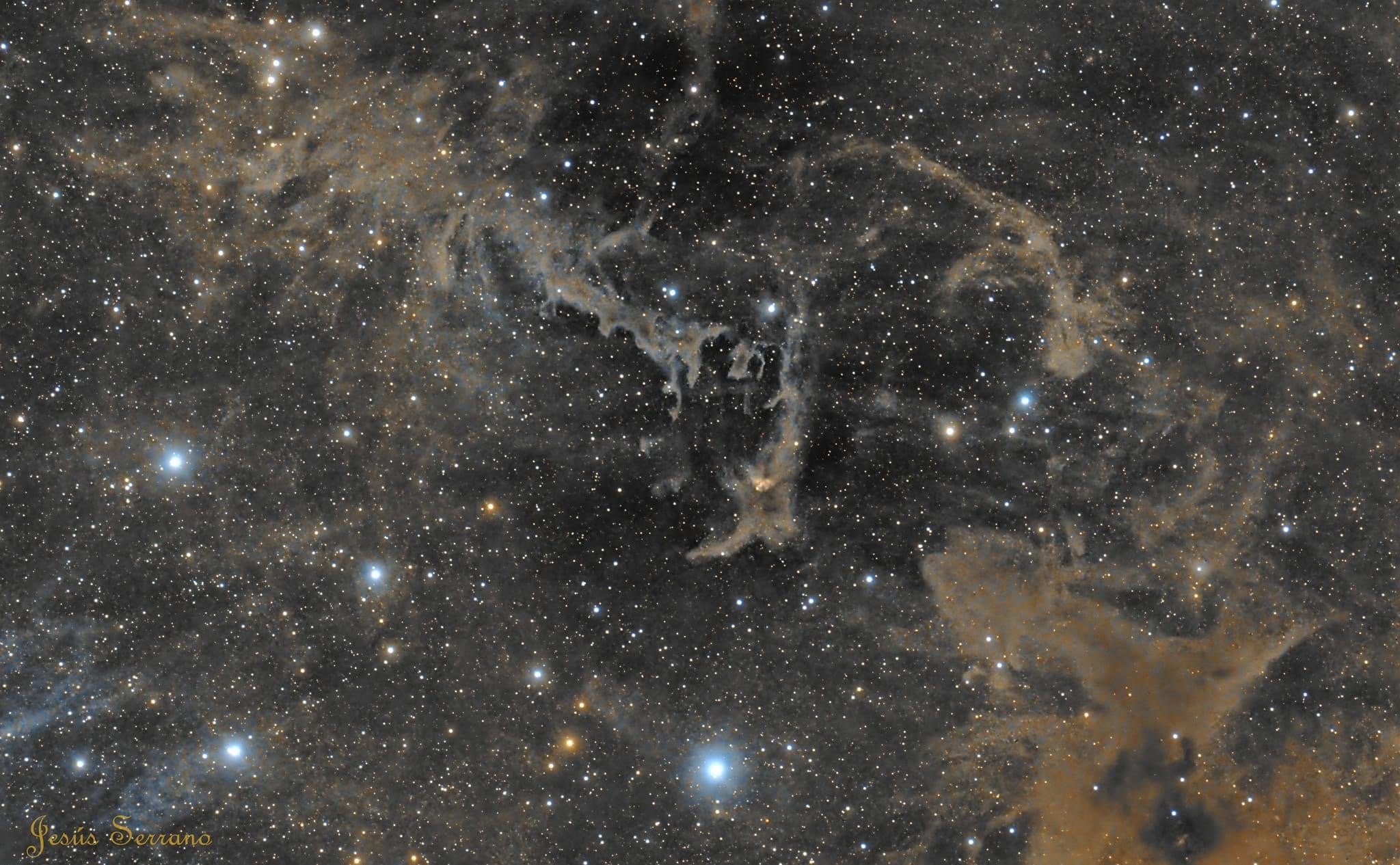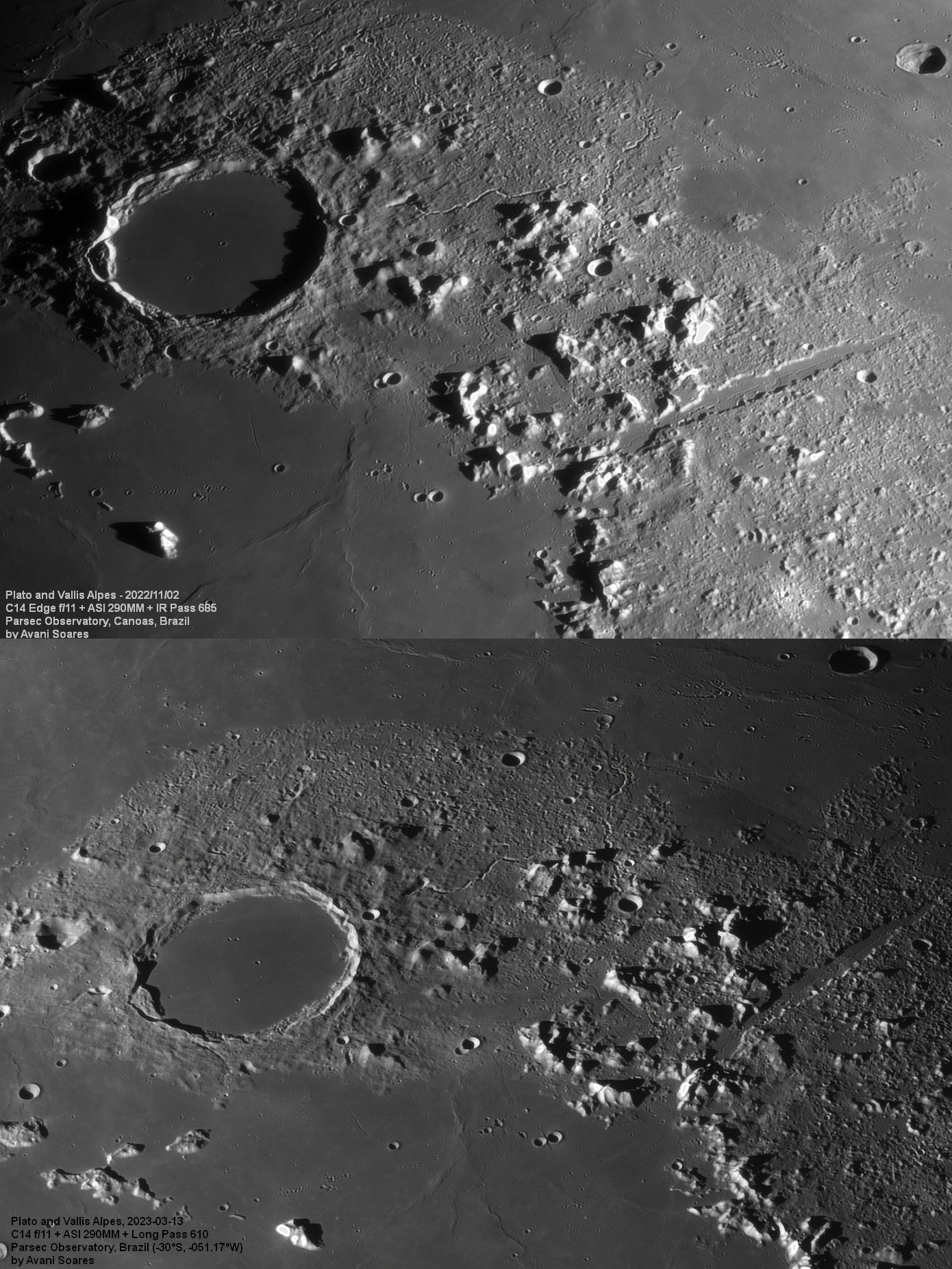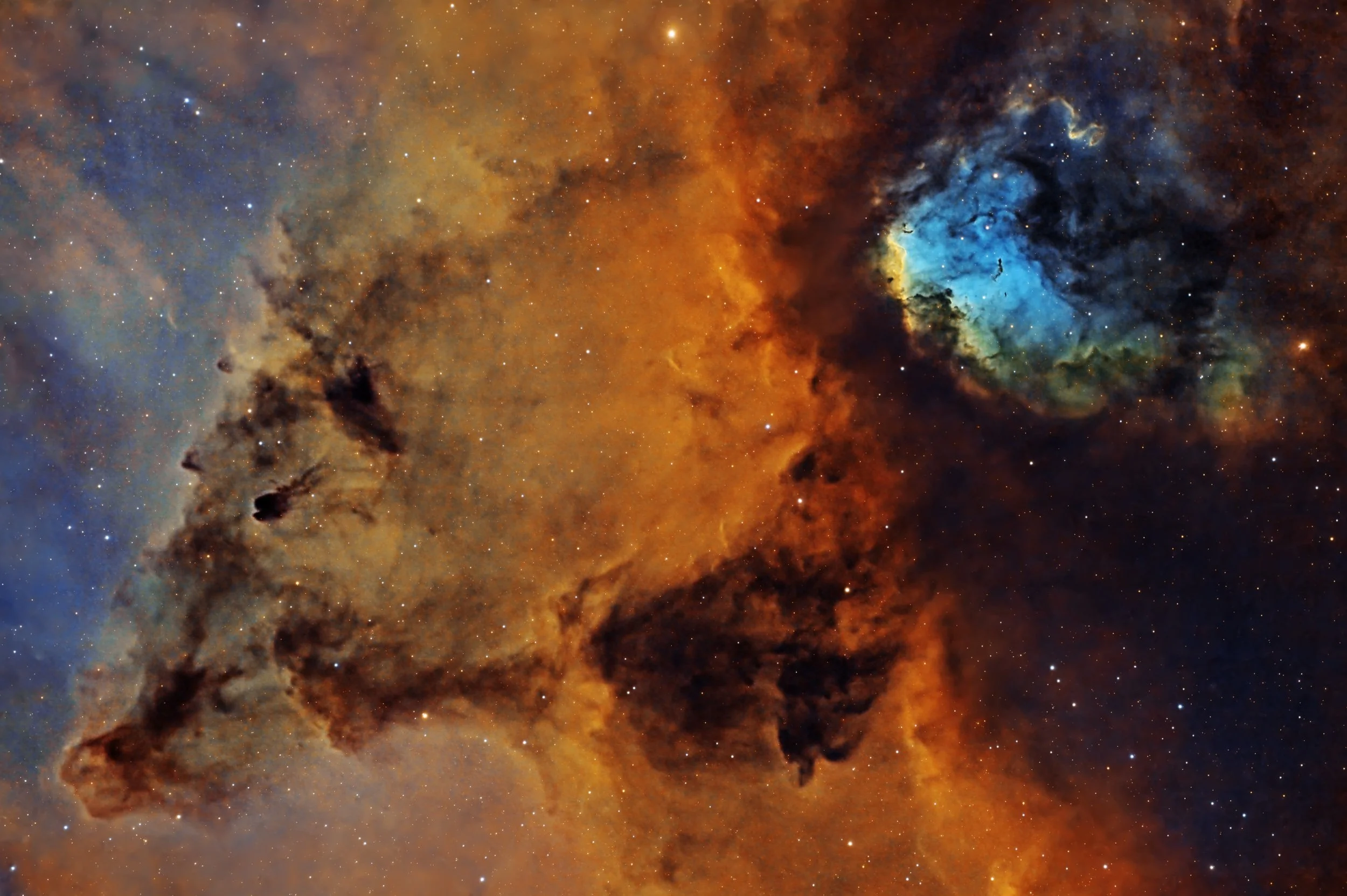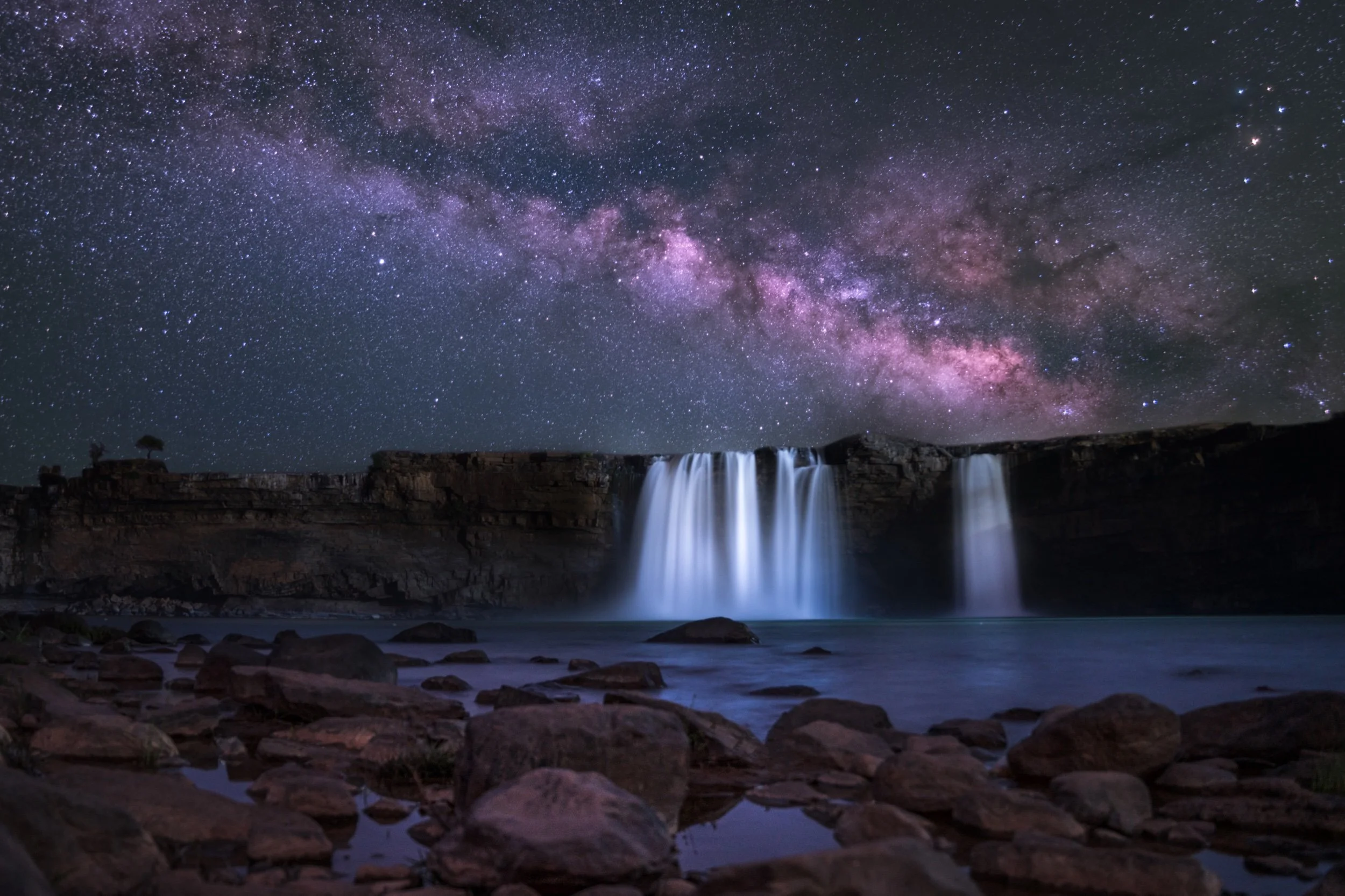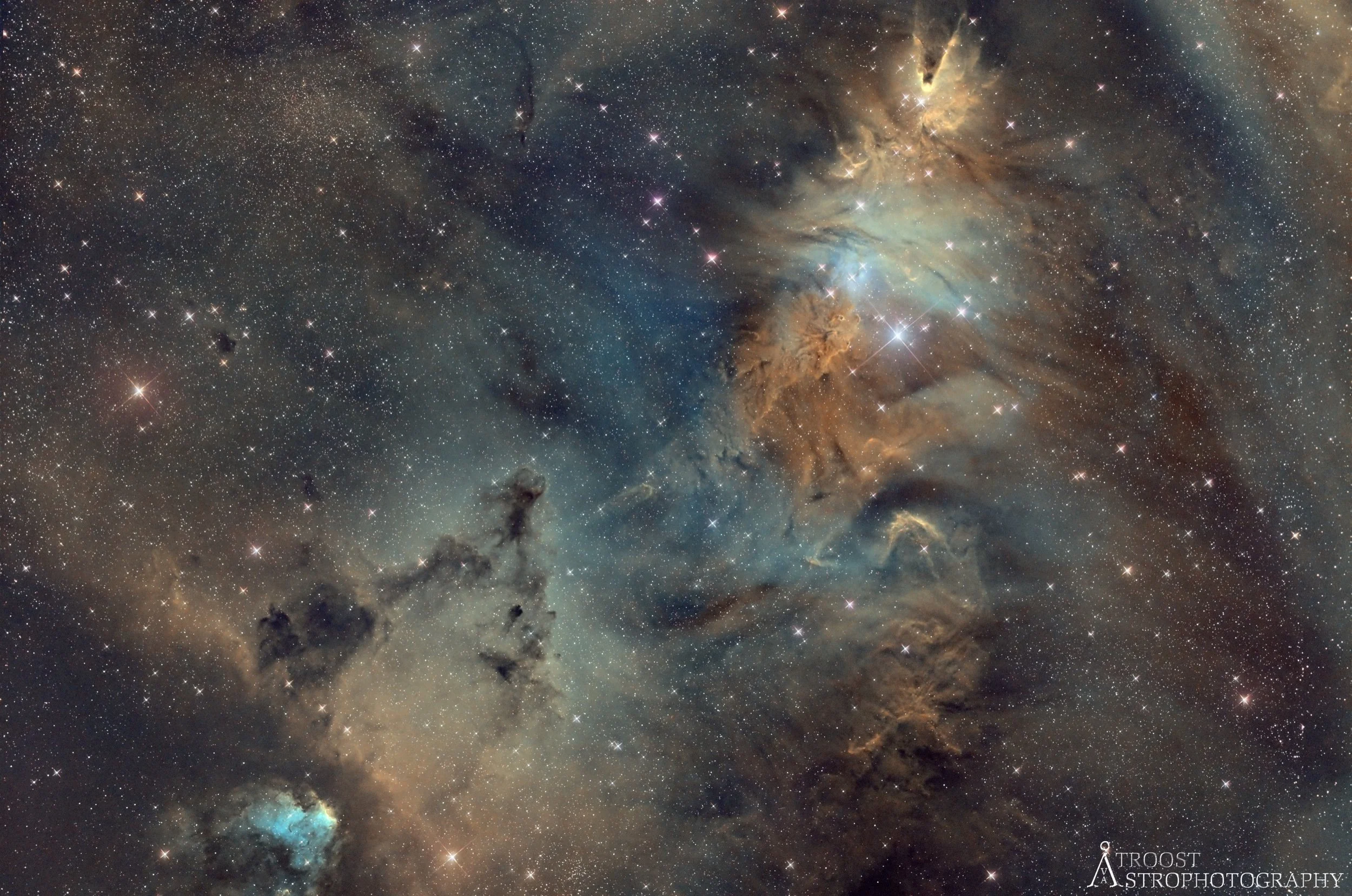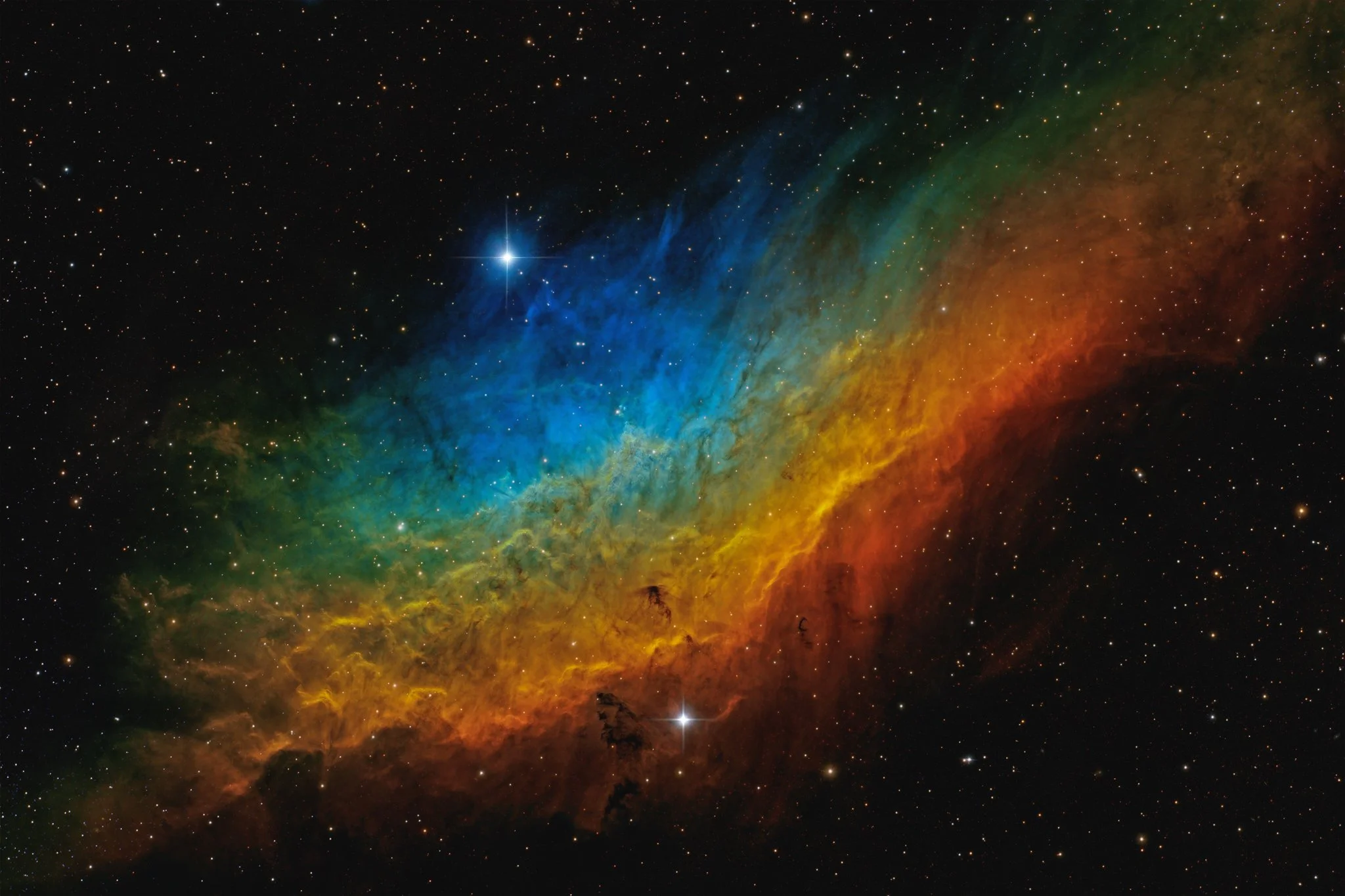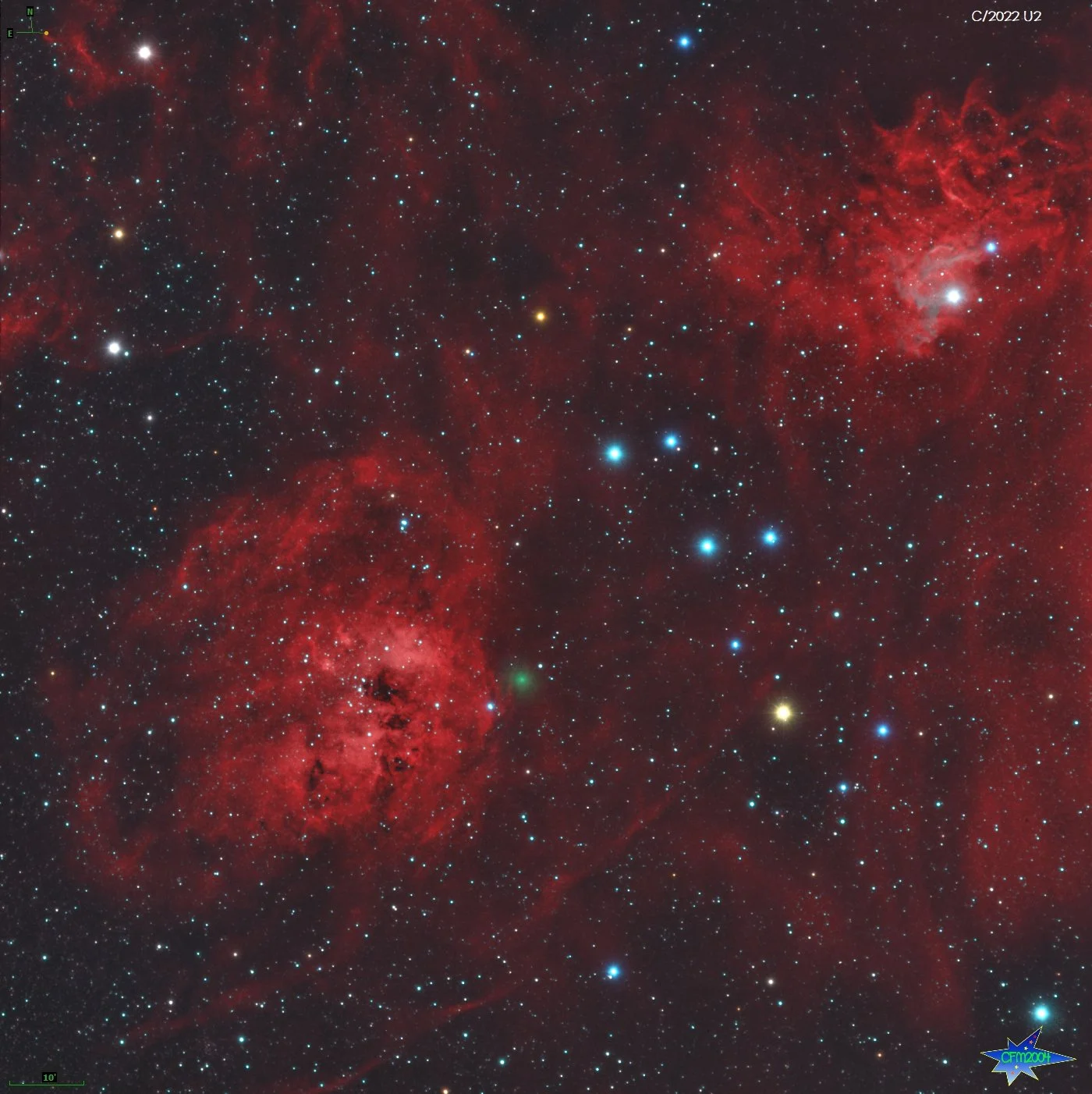
AAPOD2 Image Archives
Ngc 2174
Image Description and Details : NGC 2174 is an emission nebula located in the constellation Orion, and is also called the Monkey Head Nebula. NGC 2174 contains the open cluster NGC 2175 whose distance is known. According to the WEBDA database, this cluster is about 1,627 pc (∼5,310 a.l.) from the solar system.NGC 2174 has a size of 62 a.l.
Photo taken in France (Normandy). Set up Newton Skyvision 250/900 F/D= 3.6 on Eq8 mount.
Camera ZWO asi 6200 MM .
24 hours of acquisition with S,H,O and R,G,B filters
Copyright: Francis Bozon
Leo Triplet with Tidal Tail
Description:
Far from home, under a dark and clear sky, I had to drive 3 hours from my light polluted city, "Jeddah" to capture one of the most gorgeous targets in the sky, the Leo Triplet Galaxies with the beautiful tail of NGC3628 Galaxy. I wasn't sure if the night would be cloudy or not, I wasn't sure if it was a safe place or not, but I just packed my rig and drove to the place. Fortunately, I found a nice shepherd living there so I stayed with him, the sky was crystal clear, and the place was safe. I was able to collect 6 hours of LRGB data until the cloud passed by. But, since the sky was too dark and clear, I was able to bring out a lot of nice and breathtaking details of this beautiful region of the sky. I believe it's my best deep sky capture to date. As we can see in the image, there are three main Galaxies which are M66, M65, and NGC3628 with its 300,000 light-years long tidal tail. These Galaxies are about 35 million light year away from Earth in the constellation Leo.
Location:
Saudi Arabia, West of Saudi Arabia
Light pollution Bortle 2 (SQM 21.9)
Date: March 17th, 2023
Equipment:
- ASI2600MM Pro
- iOptron RC6
- Skywatcher EQ6-R Pro
- X0.67 Reducer
- Antlia 36mm LRGB
- ESATTO ROBOTIC FOCUSER
Integration:
- L: 62X180" (3.1 hrs)
- RGB: 20X180" (1 hr) / Each
Total: 6.1 hours
Copyright: Bakry Abdullah
LDN1082
Here is the seahorse nebula - LDN1082
This is dark nebula located 1200 light years away. It is visible in the constellation Cepheus near the flying bag and the squid nebula.
R : 56 x 120″
G : 40 x 120″
B : 40 x 120″
L : 247 x 120″
Takahashi Epsilon 160ED
Ioptron GEM45
ZWO ASI 2600MM-Pro
Baader Filters
Copyright: Julien Dufour
Dying Fast & Slow (Sharpless 216, 221 Region)
Image Description and Details : This is a region of space in Auriga showing a large and faint Supernova Remnant (Sh2-221) next an equally large and faint Planetary Nebula (Sh2-216). The latter is also often called the "Second Closest Planetary Nebula." The former may be an example of the earliest recorded supernova (~6600 years ago) as a cave drawing depicting this area of sky was found with a possible illustration of a bright light in the same area of sky, though this interpretation is not conclusive.
Altogether this field of view covers over a dozen times the apparent width of the Full Moon in our sky and was captured with a total of 44.5 hours across 9 nights of imaging (9 hours RGB, 36.5 hours evenly split between Hydrogen and Oxygen filters).
71mm F/4.9 Petzval Refractor, ZWO ASI6200MM-P, Antlia RGB & 3nm Ha/Oiii filters. Captured with APT and processed in PixInsight
Copyright: Brent Newton Photography
LDN 1228 Nebula
Image Description
Color zwo 2600mc William 81 gtf 97x300s telescope
Luminance with 2600mm, sprit telescope 120 101x300s
Mount eq6r-pro
Copyright: Jesus Cantero
Two photos, two moments, the same place!
Image Description and Details : Two photos, two moments, the same place!
How about photographing the same location in completely different lighting angles?
The attached photos were taken 4 months apart and with the sun in exactly opposite positions. In the photo above we have the Sun to the east, rising in Plato and Valiis Alps, the photo below was taken with the Sun to the west, there the Sun is setting in the same region. Photos in these conditions and of such magnitude, sublimely show the differences that the Moon offers us at every moment and show us that one day will never be the same as the other.
Plato is one of the main targets of lunar astrophotography.
A good photo of Plato should show at least 3 or 4 smaller craters present on its floor, always in a darker hue than the surrounding terrain.
But every good self-respecting astrophotographer knows that it's not easy to make these small craters appear on your floor, and for that to happen certain conditions must be met.
Firstly, an opening of no less than 250mm is ideal, not that it is impossible to register them with 200mm or even 180mm, but with 250mm it is much easier.
Secondly, the angle of incidence of sunlight must also be observed, if the terminator is too low and close, the contrast is too great making it difficult to record, if on the other hand the sun is too high, the smaller craters do not form shadows which it also makes it impossible to register them. I believe that the ideal is the Sun at an altitude of 30° to 45° so the contrast is not so great and shadows are still formed, facilitating their perception.
Thirdly, we must pay attention to seeing, with a bad seeing any recording is almost impossible, as these small craters disappear when the turbulence is strong.
Focus I won't talk because any mistake ends with a good result!
As a general rule, in order to get an impressive photo of at least some of these small craters, they would have to be briefly visible during real-time computer screen capture. If so, we learned that after the best stacked frames, these small craters will show up perfectly as seen in the attached photo.
Vallis Alpes, in the south of Mare Frigoris, not far from Cassini crater and Plato's Great Eastern Plain, is one of the most spectacular valleys on the moon.
Seen in this image, Vallis Alpes (Alpine Valley) is a feature that extends 166 km from Mare Imbrium, running northeast to the edge of Mare Frigoris. This valley was discovered in 1727 by Francesco Bianchini. The valley is narrow at both ends and widens in the center to be about 10 kilometers in diameter.
The bottom of the valley has a flat, lava-flooded surface with a narrow 'channel' winding through the middle. This channel is generally thought of as a "graben", an area between two parallel faults that have fallen below the surrounding area. The narrow inner channel is believed to have formed after the formation of the Imbrium basin, after the lava flows into the sea. It probably corresponds to a 'lava tube' that collapsed in a later geological episode due to the high velocity and low viscosity of the magma.
It is very interesting to know that channels are common on the moon, considered one of the most fascinating volcanic features due to their wide range of scales (from 100 meters to over 100 km in length) and the morphologies they present (linear, curved or sinuous). .
Channels typically form when lava flows erode the existing surface, melting the substrate, removing mechanical material, or a combination of thermal and mechanical processes. However, some may have been lava tubes, rilles, that suffered roof collapse after their formation.
Trying to detect this relatively narrow and winding channel that runs along the bottom of Vallis Alpes is one of the favorite challenges of lunar observers, its exact dimensions have not been determined, but its vision is a very satisfactory test, as are the small craterlets on the Plato floor. .
I hope these tips are of some use to anyone like me who likes to venture into lunar photography!
PS: The bottom photo is just a result of stacking in AS!3 with a sharpness of 60% and nothing else. There is no post processing, Registax, Astrosurface, Photoshop or any other editing program was not used, nor was brightness or contrast adjusted. I've been developing a capture line on lunars for years to avoid any post processing as much as possible, I'm almost there.
Avani Soares (Astroavani)
Copyright: Astroavani
Abell33
Image Description and Details : Abell 33 is a planetary nebula 2700 light-years away in the constellation Hydra, located behind the star HD 83535, making it look like a diamond ring.
APM SD Apo (Fpl53) 140 F7 (979 mm)
ZWO ASI 533MC Pro + iOptron GEM45
ZWO ASI 220MM Mini + ZWO OAG-L
ZWO EAF ZWO + EFW 5X2
ZWO AsiAir Plus
Mar 2023
Optolong L-Ultimate (3 nm): 120X600"
Optolong Uv Ir cut: 30X60” (star color)
Tot: 20h 30’
Modena (Sqm 18.3-18.9 Bortle 7,5-8), Italy
Copyright: Andrea Arbizzi
Ngc2835
NGC 2835 is an intermediate spiral galaxy located 35 million light years away in Hydra.
The galaxy spans around 65000 light years across which is around 1/2 the size of our galaxy. There are multiple twisting spiral arms which create the illusion of an eye at the center. Numerous bright blue regions indicate high levels of near ultraviolet light which are star forming regions.
The galaxy hosts a massive black hole at its center.
Imaged in LRGB and H alpha on Planewave CDK 1000 at Observatorio, El Sauce, Chile.
Image Processing: Mike Selby and Mark Hanson
The Razorback and the Little Tulip - B39 and LBN902
Image Description and Details : I can find no direct information about how far away these objects are, but from our perspective, they are just to the northwest of the Cone and Foxfur nebulas as well as the Christmas Tree cluster in Monoceros. The Cone nebula is about 2,700 light years away from us, but these objects could be much closer or much farther away.
The dark nebula, B39, resembles the shape of a feral hog to me, so I gave it that name. And the bright region, LBN902, reminds me of the larger Tulip nebula in Cygnus.
Details: Celestron EdgeHD 1100 telescope with 0.7x reducer; ZWO ASI6200MM camera; 10Micron GM1000 mount; Chroma 3nm narrowband filters; Bortle 8; 19hrs 6min exposure time.
Copyright: Copyright 2023 by the Accidental Astronomers
NGC 5139 - Omega Centauri Globular Cluster
Image Description and Details : Containing around one billion stars, this target is very bright and only requires a few images to capture the details. To preserve the core I used a series of masks when stretching the image.
Location of capture: Heavens Mirror, Yass, Australia by Martin Pugh
Light frames:
Red: 6 x 600 seconds
Green: 6 x 600 seconds
Blue: 6 x 600 seconds
Luminance: 6 x 600 seconds
Total Integration: 4 hours 10 minutes
Equipment details are:
Telescope: Planewave CDK17
Mount: Software Bisque Paramount ME II GEM
Camera: SBIG STXL-11002
Filters: Astrodon Gen2 E-Series True Balance Red, Blue, Green and Lum
Copyright: Neil Corke
Season of Milkyway
Image Details:
This beautiful frame captured at February end in this year 2023 .
Milkyway's core & Sagittarius arm started rising just before the Sunrise.
Picture taken in-front of a beautiful waterfall at 4 am in February end ,2023.
Milkyway Core with T-Pot of Sagittarius & Scorpius constellations and Rho-Ophuichi, all are clearly visible.
From now on every upcoming month it's rising time will be 1 hour backward from sunrise .
In July it will be seen throughout the night ( sunset to sunrise). In October it will be present in the sky for just 1 hour and 30 minutes after Sunset.
After early November the Milkyway core can't be seen in the sky and the season will end.
Camera : Sony a7R III
Lense : Sigma 24-70 ( 24 mm used with f 2.8)
Tripod : Manfrotto 290
For Sky total 12 light frame and 8 dark frame taken in shutter speed of 15 sec with ISO 3200
For Foreground 1 frame taken at Blue hour in 20 sec with iso 3200
Stacked in Seaquator , Blend in PS , Process in LR & PS
Copyright : Anupam Naskar
Christmas Tree Cluster and Cone Nebula
Image Description and Details : Taken with Takahashi Epsilon 160ED, ToupTek 2600KMA, EQ6-R pro, Mgen3, Antlia Edge filters at a Bortle 5 area.
20 x Ha, 20 x Sii, 26 x Oiii à 180 seconds each plus RGB stars.
Copyright: Ava Troost Astrophotography
Big solar prominence
Image Description and Details : Big solar prominence taken with an H-alpha filter and an apochromatic refractor.
Copyright:: Salvo Lauricella
A freeze-frame on the Prawn Nebula & Many More
Image Description and Details : This wide field picture features many celestial jewels, including but not limited to IC 4628, NGC 6268, NGC 6231, & NGC 6244. The main object drawing the astronomer attention is most probably IC 4628, a bright Nebula appearing in the constellation Scorpius and located somewhere 6,000 light years from our solar system. Also dubbed the "prawn nebula", it is believed to be a massive stellar nursery, where new stars are forming. Scientists classify it as an emission nebula because its gas has been energized, by the radiation of nearby stars.
Acquisition details:
Processing : @ae_astrophotography
Data : telescope l
Scope : Takahashi FSQ 106 located in Australia
Filters : Sii, Ha, Oiii which gives the so-called "Hubble Palette"
Total integration time : 15H
Copyright: @ae_astrophotography
NGC 1499 - California Nebula
Image Description and Details : To make this a little different to the usual red images of this target, I used narrowband filters and processed this in the SHO Hubble palette resulting in a colourful rainbow-like image. The OIII signal was however very faint, so I captured extra data with this, 19 hours in all, resulting in 48 hours total integration time.
Date of capture: Jan 13 to Feb 17, 2023
Location of capture: Castilléjar, Spain
Light frames:
Ha: 83 x 600 seconds
OIII 114 x 600 seconds
SII: 74 x 600 seconds
Red: 25 x 180 seconds
Green: 24 x 180 seconds
Blue: 25 x 180 seconds
Total Integration: 48 hours 55 minutes
My equipment and details are:
Telescope: Takahaski FSQ106
Mount: Software Bisque Paramount MX+
Camera: Moravian C3-16000 PRO
Filters: 3nM Chroma Ha, OIII, SII and Red, Blue, Green for the RGB stars
Guiding: Moravian C1-1500 and OAG
Focuser: Moonlite NiteCrawler WR35
Copyright: Copyright: Neil Corke
Comet C/2022 U2 Atlas in Auriga
Image Description and Details : Februar 12th 2023 - time 18.00 u.t.
Location: San Romualdo - Ravenna (Italy)
Tecnosky AG70 on Avalon M1
QSI540ws cooled -20
Autoguide with Celestron OAG and QHY174MM
Astrodon RGB GenII E-series and Narrowband 3nm filters
HA-RGB: Ha 15x5min bin2; R 15x2min, G 15x2min and B 15x2min Bin1
Acquired with: Astroart8
Calibrated with bias, dark and flat
Processed with: Astroart8, Paint Shop Pro2023 e plug-in vari.
Copyright: Cristina Cellini
NGC-6188 Chaos & Hope
NGC 6188 is a dazzling emission nebula located in the southern constellation of Ara, about 4,000 light-years away from Earth. This celestial object is a site of active star formation, boasting a cluster of hot, massive stars that illuminate the surrounding gas and dust with their intense radiation.
M95-M96
Image Description and Details : The M96 group, also called the Leo I group, is a collection of galaxies in the constellation Leo. The group contains between 8 and 24 galaxies, including three Messier objects. It is one of the many clusters in the Virgo supercluster.
M96 is the ‘dominant’ galaxy in the group, i.e. the most massive. M95 and M96 are both barred spiral galaxies, of comparable dimensions and a little smaller than our Milky Way (93 000 AL for M96 and 73 000 for M95).
At the top right is the elliptical galaxy M 105 from the bottom, then Ngc 3384 and then Ngc 3389, the highest in the image.
We can also see a beautiful spiral galaxy (seen – by contrast – from the edge) camouflaged in one of the spiral arms of M96.
Other more distant galaxies can be detected in the picture.
Photo taken in Normandy (France) . 7H 15 in L;R,G,B
Set up: Newton skyvision 250 900 f/d 3.6 on Skywatcher mount. Camera ZWO Asi 6200 MM.
Processing APP-Pixinsight-Photoshop
Copyright: Francis Bozon
Abell 39
Image Description and Details :
Abell 39 planetary nebula made from Tona ( Bareclona ) bortle 5 sky with an Orion Optics VX8 200mm f900mm f4.5 reflector and Zwo 1600mm pro camera on skywatcher mount Eq6- r pro. For guidance, the evoguide 50 f230 with zwo178 mm camera has been used. There are a total of 65 * 300s in OIII filter on February 3 and 65 * 60s RGB to each channel on February 12, all shots acquired with NINA 2.0 and processed with Pixinsight 1.8.9-
Copyright: Jordi Compte
NGC 4038/4039 - Viennese waltz in space
Image Description and Details :
For me as an Austrian these are clearly 2 galaxies dancing Viennese Waltz
Astrophysicists consider NGC 4038 / NGC 4039 as 2 interacting galaxies
at a distance of about 75 million light years in the constellation Corvus.
This pair of galaxies is also called Antennae galaxies, named for the long tails of gas and dust they eject.
IAS 10" Newton f/4.5 / QHY268M65
L 65 / R 27 / G 29 / B 26 x 120s (4h54min)
Remote IAS Observatory Hakos, Namibia
Copyright: Herbert Walter


